As a leader, you know what’s at stake. 91% of customers are more likely to make a repeat purchase after an outstanding customer service experience. But by 2026, excellent service means more than just politeness —it means proactive, personalized, and immediate action.
If your customer service team doesn’t have clear goals, it will only answer calls. The right customer service goals will turn your contact center from a cost center into a revenue stream. This guide provides a framework for developing ambitious, measurable customer service goals that drive loyalty and business growth.
See what Nextiva can do for your CX
Short on time? Experience our AI-powered contact center in minutes through quick, on-demand demos.
What Are Customer Service Goals?
Customer service goals are specific, measurable objectives that managers set to improve the quality of customer interactions. They serve as a guideline for the customer service team and direct all actions — from day-to-day operations (e.g., faster call answering) to long-term strategy (e.g., reducing customer churn). Effective goals bridge the gap between customer needs and business requirements, ensuring every chat, email, and phone call contributes to the company’s success.
Why You Need Customer Service Goals
Imagine a call center where Agent A prioritizes speed (and handles customers quickly), while Agent B prioritizes in-depth conversations (and spends 20 minutes per call). The result? Inconsistent data and confused customers. Clearly defined goals prevent this by:
- Providing direction and stability: Comprehensive and clear goals eliminate guesswork, giving your employees confidence in their workflow.
- Simplifying team/employee management: Measurable customer service goals with specific standards and benchmarks make it easier to provide objective feedback and offer clear paths to improvement.
- Building team alignment and collaboration: Goals clarify shared objectives across different departments, encouraging everyone to work together toward common milestones.
- Increasing customer satisfaction: Specific customer service goals focused on delivering exceptional customer experiences set you apart.
The SMART Approach to Goal Setting
While brainstorming ideas is a good starting point, goals need structure to be effective. That’s where SMART goals come in.
Your customer service goals should be:
Specific
Avoid vague statements. For example, if your live chat response time is currently 2 minutes, but customers expect faster replies, a specific goal would be: “Achieve an average live chat response time of 60 seconds or less by the end of the next quarter.”
Measurable
Use quantifiable metrics to track progress, like:
- Customer Satisfaction Score (CSAT) – Measures how happy customers are with support interactions.
- Net Promoter Score (NPS) – Indicates customer loyalty by asking how likely they are to recommend your business.
- Customer Churn Rate – Tracks how many customers stop doing business with you over a set period.
- First Response Time (FRT) – Measures how quickly agents respond to customer inquiries.
For instance, instead of saying, “more satisfied customers,” a measurable customer service goal would be, “increase CSAT from 60% to 80% within six months by improving agent training and response quality.”
Achievable
Set ambitious yet attainable goals. Unrealistic targets can demotivate your team.
If your chatbot currently resolves 30% of inquiries without agent intervention, an achievable goal would be: “Increase chatbot resolution rate to 40% over the next two quarters by refining responses and improving AI training.”
Relevant
Goals should align with your company’s overall mission and customer service strategy. If your company values fast, friendly support, then setting goals related to response time and personalization makes sense. On the other hand, if your focus is cost efficiency, then improving self-service options or reducing cost per contact (CPC) would be more relevant.
Time-bound
Setting deadlines ensures accountability and progress tracking, and breaking large goals into smaller time-bound checkpoints also helps. For example, if the goal is to launch an omnichannel support strategy, set milestones like:
- Month 1: Identify the top three additional channels based on customer demand.
- Month 2: Train agents on new platforms.
- Month 3: Roll out the first new channel and monitor performance before expanding further.
Clear, focused customer service objectives are necessary for any customer retention strategy. Customers who feel satisfied and cared for after interacting with your customer service team member will be far more likely to return.
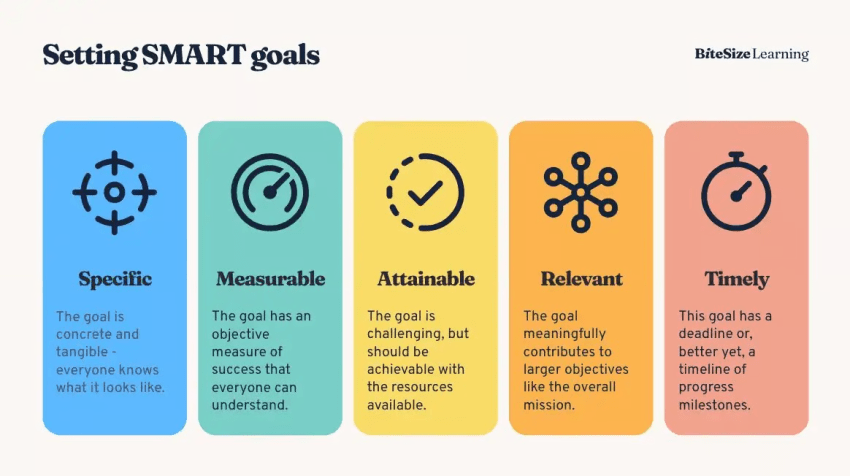
Now let’s take a look at 13 customer service goals to inspire your customer experience (CX) strategy.
Customer Service Department Goals
These goals focus on overall strategy and efficiency for customer interactions.
1. Expand your communication channels
Customers expect to connect with businesses on their own terms. Companies are more likely to text than chat by a 3:1 ratio. While phone calls and email remain important, introducing different contact formats is essential to reach a broader audience. Think beyond traditional channels and consider options like:
- Live chat: Offer real-time support directly on your website for immediate assistance.
- Chatbots: Use AI-powered chatbots to answer FAQs, qualify leads, and provide 24/7 support.
- Messaging apps: Integrate with popular platforms like WhatsApp, Facebook Messenger, and Instagram to reach customers where they already are.
- Social media: Support and engage with customers on platforms like Twitter, LinkedIn, TikTok, and Facebook.
- Video chat: Offer personalized support and product demonstrations through video conferencing.
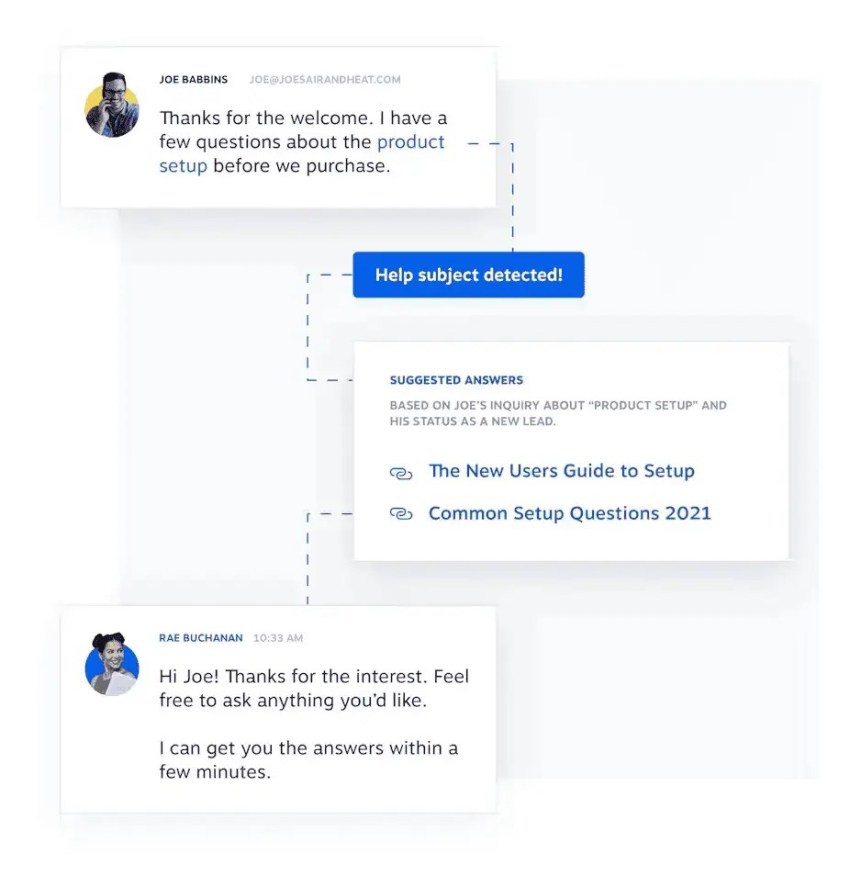
Offering support across multiple channels improves accessibility and convenience for your customers. Imagine a busy professional who prefers a quick chat interaction during their lunch break or a tech-savvy customer who finds it easier to troubleshoot an issue through a video call. You demonstrate your commitment to meeting these customer needs and exceeding expectations by providing these options.
How to accommodate multiple contact formats:
- Analyze customer data: Identify your target audience’s preferred channels through surveys, website analytics, and social media engagement.
- Prioritize based on need: Focus on implementing the most popular channels first, then gradually expand your offerings.
- Ensure integration: Use omnichannel customer service software to integrate all channels and provide a consistent customer experience.
2. Implement an omnichannel strategy
86% of customers expect communications to transition smoothly between channels. Failing to meet this expectation can lead to frustration, confusion, and lost customers.
Omnichannel may sound complex, but it boils down to putting the customer at the center of your customer service strategy. It’s about providing a consistent and seamless experience across all channels, so customers can effortlessly switch between phone calls, emails, live chat, social media, and any other touchpoint without missing a beat.
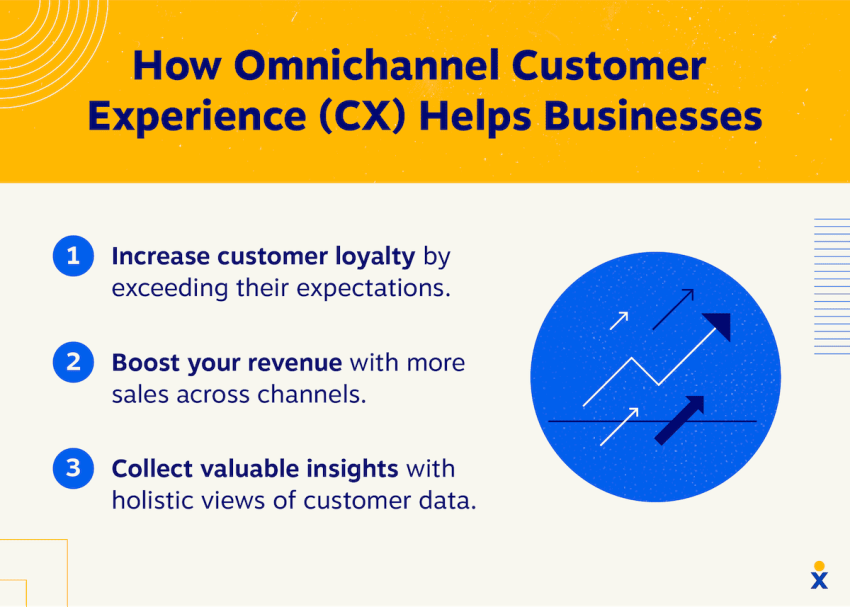
Say a customer starts browsing products on your website, and then has a question they can’t find the answer to. They initiate a live chat with an agent, who provides helpful information and guides them toward a purchase.
Later, the customer has a follow-up question and sends an email. With an omnichannel approach, the agent responding to the email has full context from the previous chat interaction, ensuring a smooth continuation of the conversation.
What do you need to go omnichannel?
- Map the customer journey: Visualize how customers interact with your business across different touchpoints to identify potential pain points and improvement opportunities.
- Break down data silos: Integrate your systems and data so customer information is accessible across all departments and channels.
- Empower your team: Train customer service reps and give them unified communication tools to handle inquiries seamlessly across all channels.
3. Reduce cost per contact (CPC)
Cost per contact (CPC) is one of the most effective ways to gauge your call center’s health. It reflects the impact that operational changes have on your bottom line.
To calculate CPC, add up all your contact center costs, including salaries, software, infrastructure, and telecommunications, and then divide that total by the number of contacts handled across all channels. You’ll get a benchmark for evaluating the efficiency of your customer service operations.
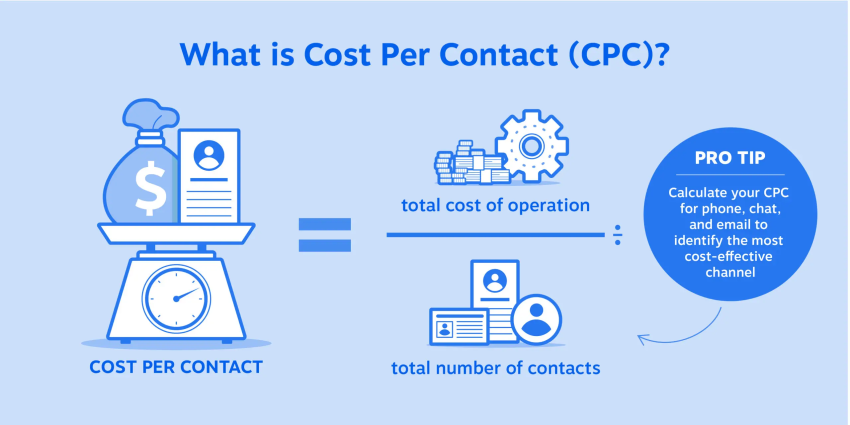
Reducing CPC is important because it improves profitability, increases efficiency, and enhances customer engagement. To reduce CPC, focus on optimizing self-service options, automating workflows, improving first contact resolution, investing in agent training, and analyzing channel performance.
4. Innovate with the industry
Expect your competitors to be on top of the latest customer service technologies and trends. Setting a goal around consistently researching and implementing these technologies will help you stay relevant.
Employee-centric technology like workforce management tools is transforming contact centers’ operations.
Remaining up to date with customer-facing technology and trends in customer service is also essential.
In 2021, Domino’s launched a pilot program in Houston, Texas, using autonomous delivery vehicles called “DomiNo’s DXP.” These AI-powered bots navigate sidewalks and roads to deliver pizzas directly to customers’ doorsteps. This innovative approach to delivery offered several benefits:
- Faster delivery times: The bots could navigate traffic and reach customers quicker than traditional delivery drivers, especially during peak hours.
- Reduced contact: With contactless delivery, the bots minimized the risk of COVID-19 transmission and appealed to hygiene-conscious customers.
- Increased efficiency: The bots allowed Domino’s to handle more orders without needing additional human drivers, potentially reducing operational costs.
Staying ahead of the curve in customer service technology can go beyond mere efficiency and bolster customer experiences, bringing lasting benefits to both businesses and consumers.
5. Prioritize mobile support
Mobile customer service is no longer the future — it’s the present. Customers expect to access support and find information on their smartphones with the same ease and convenience as they do on their desktops.
This means optimizing all aspects of your customer support for mobile, from your website and knowledge base to your communication channels and self-service tools.
A few things you can do to make your customer support mobile-friendly:
- Build a responsive site design that adapts to different screen sizes and makes it easier for customers to navigate and find what they’re looking for.
- Optimize user experience on mobile devices and make features like chatbots, articles, and FAQs easily accessible and usable on smaller screens.
- Use UX experts to identify potential pain points and optimize the mobile experience for your customers.
- Integrate SMS or text message support into your channel strategy to quickly connect with an agent or receive updates without downloading an app or navigating a website.
- Use app push notifications to provide timely updates, reminders, and personalized offers.
6. Automate strategically to fill in human gaps
If you’re skeptical of the role of automation in customer service, turn to the 79% of companies that are confident in its future.
Chatbots, AI-powered solutions, and self-service portals can streamline operations, free up valuable agent time, and enhance the customer experience.
Not only does automation reduce customer service costs, but it also allows for 24/7 support. This offering would be far more costly if an organization were to rely fully on its human employees.
Of course, automation can only go so far. It’s less intuitive than an agent and lacks a certain human touch. That’s why it’s important to implement automation strategically rather than relying on it for your customer service strategy.
Wondering how automation can help? Start with the following ideas to integrate it for an exceptional customer service strategy:
- Deploy intelligent chatbots: Use AI chatbots to handle simple inquiries, provide product information, and guide customers toward self-service resources.
- Automate notifications: Set up automated notifications to keep customers informed about order updates, support ticket progress, and other relevant information.
- Streamline data collection: Use automation to collect customer data, track interactions, and analyze trends to identify areas for improvement.
Watch: How automation and AI are reshaping the contact center.

Customer Service Manager Goals
These goals focus on leadership, training, and operational improvements.
7. Survey customers consistently
Your customers are your most valuable source of insights. They experience your products and services firsthand and give you a unique perspective on what works well and where there’s room for improvement. Actively seeking their feedback through consistent customer surveys is essential for building a customer-oriented strategy.

“Your most unhappy customers are your greatest source of learning.”
— Bill Gates
But simply sending out surveys isn’t enough. To bank on the power of customer feedback, consider these key aspects:
- Choose the right tools: Select a user-friendly survey platform to easily create and distribute surveys, analyze responses, and track key metrics.
- Ask effective questions: Formulate clear and concise questions and use a mix of question types, including multiple-choice questions, rating scales, and open-ended questions, to collect both quantitative and qualitative data.
- Optimize the survey experiences: Make the survey easy to navigate, mobile-friendly, and worth the customer’s time. Keep it concise and targeted, and consider offering incentives to encourage participation.
- Analyze and act on feedback: Analyze customer feedback to identify trends, prioritize areas for improvement, and measure the changes you implement.
8. Improve customer onboarding processes
First impressions count, and your customer onboarding process sets the stage for a positive long-term relationship. A smooth and efficient onboarding experience demonstrates your commitment to customer success and helps build trust from the start. This includes clear communication, setting clear expectations, and providing timely support throughout the onboarding journey.
Personalization is also important. Tailor the onboarding process to the customer’s needs and preferences to show real value. Consider using automation to streamline tasks like account setup and welcome emails so your team can focus on providing personalized support and guidance.
Take the IT Consulting Firm AVIT, for example. AVIT decreased its new client onboarding time by two-thirds with the help of Nextiva’s interface and supportive team.

“When you run 10 to 12 projects a month rolling out restaurants, communication is critical. You’re dealing with multiple general contractors, multiple concepts and brands, and support, taking them from install and onboarding to our support team.”
— Kelly Green
If you plan to improve your client onboarding strategy this year, lean on the tools that make it possible.
9. Develop a customer appreciation strategy
To encourage loyalty and advocacy, go above and beyond to show your customers how much you value them.
44% of consumers are willing to switch to brands with a greater focus on personalization. Developing a customer appreciation strategy builds strong relationships and positive customer connections. You could offer exclusive perks such as discounts, early access to new products, or loyalty programs.
Personalize your communications by sending birthday messages, thank you notes, or even handwritten cards to show you care. Surprise and delight your customers with unexpected gifts or gestures of appreciation to create memorable experiences that will turn them into a loyal customer.
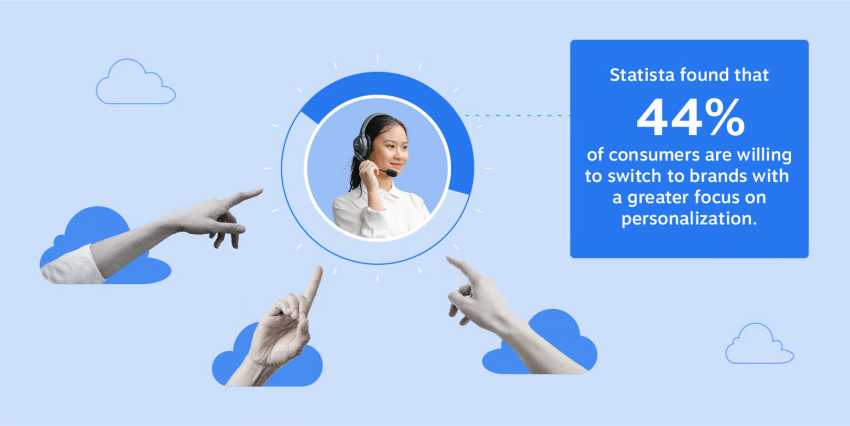
Countless customer service examples embody an impactful customer appreciation strategy. One that stands out is Picky Bars’ Picky Club.
This superfood company’s subscription service goes beyond sending customers their advertised products. They offer free perks like T-shirts to excite customers and make them feel cared for.

10. Help agents grow
Investing in your customer service team’s growth and happiness will benefit your bottom line. You’ll attract the best talent possible when you’re perceived as a workplace that invests in its workers. Satisfied employees also treat your customers better, in turn improving your customer retention rate.
So how do you go about investing in your employees’ growth?
- Provide ongoing training: Improve product knowledge, communication skills, and customer service best practices. This can include workshops, online courses, mentoring programs, and internships.
- Promote a feedback-rich culture: Encourage open communication, and regularly provide positive and constructive feedback. Conduct regular one-on-one meetings to discuss performance, identify opportunities for improvement, and provide individual advice.
- Empower and recognize: Give agents the autonomy to handle any customer issue and make decisions independently. Recognize and reward their achievements to promote a sense of ownership and motivation.
- Promote work-life balance: Create a supportive work environment that prioritizes employee well-being. Offer flexible work arrangements, generous time off policies, and resources to support mental and physical health.

“Real-time analytics blended with coaching and personalized learning pathways is how we are going to bring on the next generation of live assistance as the bar for experience management continues to rise.”
— Martin Hill-Wilson
Customer Service Representative Goals
These goals focus on direct customer interaction and performance.
11. Amaze with first response time (FRT)
Customers value quick responses. Nearly one-third expect an email response within an hour, and social media expectations are even higher.

How to achieve it:
- Invest in the right tools. Use an integrated business communication platform to respond faster.
- Optimize staffing. Ensure you have enough agents to handle customer inquiries promptly.
- Improve scheduling. Avoid multitasking and assign agents to specific channels to increase focus. For example, dedicate a customer service agent solely to live chat to reduce response times.
- Track and set goals. Monitor first response time across all channels and set incremental improvement goals.
12. Use social media creatively
Social media isn’t just for sharing updates and connecting with friends. It’s a great tool for businesses to connect with customers. With nearly half of all customers researching social media before making a purchase, using these platforms strategically can build relationships, address concerns, and improve your brand’s reputation.
For example, companies like Starbucks track when they’re mentioned on Twitter and regularly engage with their users. Whether it’s answering a question about operations or expressing gratitude for their customers, they come across as approachable and helpful.
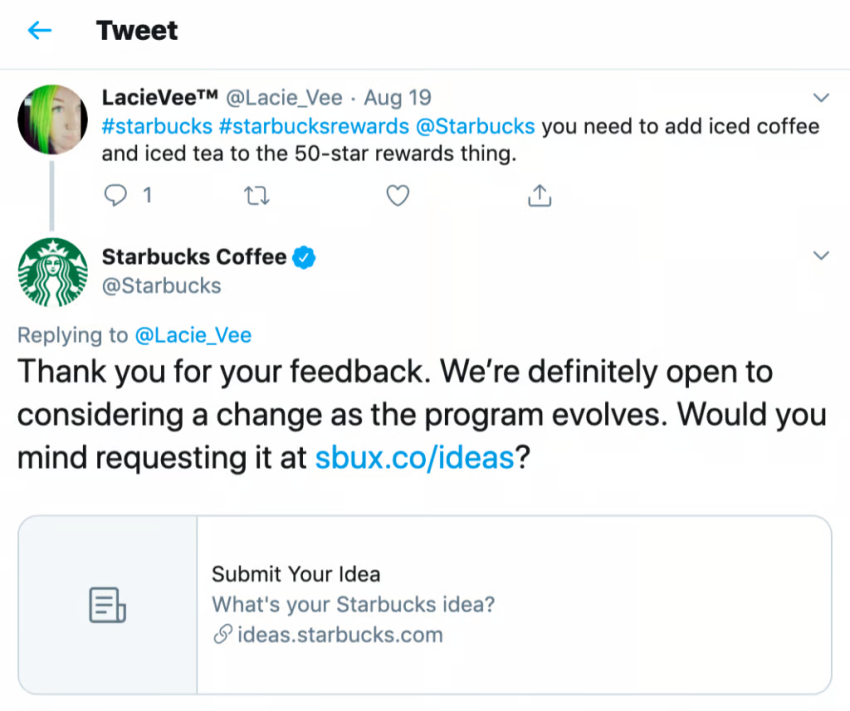
But social media is more than a reactive tool. Use it creatively to proactively engage with your audience, share valuable content, and build a strong online community. Here are some ways you can do it:
- Provide personalized support: Respond to direct messages and comments promptly and address customer concerns with empathy and professionalism.
- Showcase customer success stories: Share positive testimonials and case studies to build trust and show the value of your products or services.
- Offer exclusive promotions: Run social media contests and offer exclusive discounts to reward your followers and generate excitement.
- Go Live!: Host live Q&A sessions or product demonstrations to connect with your audience in real-time and answer their questions.
13. Empower customers through self-service tools
Customers want quick answers without calling a customer support team. They want intuitive, customer-facing tools.
Take Apple Support, for example. Apple offers an integrated search tool and personalized flow options for customers to click on based on their questions. This simple, user-friendly knowledge base keeps customers in control as they resolve their concerns. Of course, Apple didn’t just guess what its users needed.
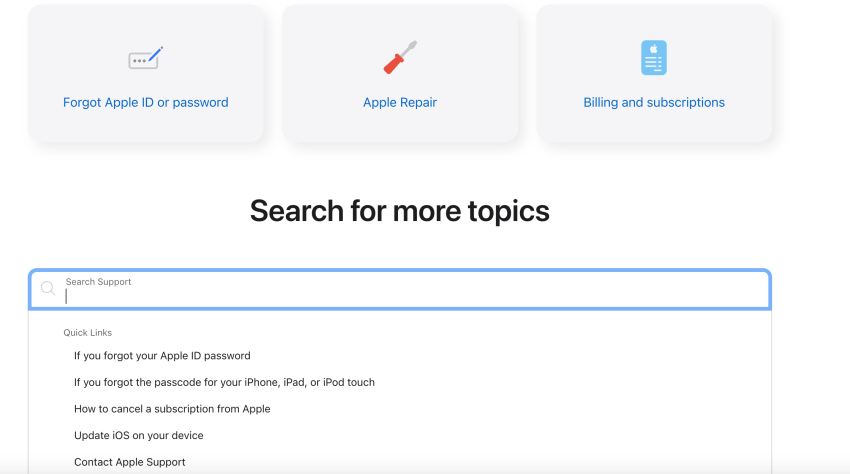
To create intuitive self-service tools:
- Make them easy to find: Prominently display your self-service resources on your website and make them easy to navigate.
- Keep them up to date: Regularly update your knowledge base with new information and ensure content is accurate and relevant.
- Offer a variety of formats: Provide information in different formats, such as articles, videos, and interactive tutorials, to cater to different learning styles.
- Gather feedback: Solicit feedback from customers on their favorite self-service option and experience to see where you can improve.

“The goal isn’t just to solve customer problems — it’s to prevent them from happening in the future. Instead of addressing the issue over and over with each customer that calls, companies should update and improve their products so that customers don’t have to call in the first place.”
— Blake Morgan
Customer Service Goals Examples
Need specific language for your next performance review? Here are 5 examples tailored for different roles:
- For customer service representatives (CSRs): Maintain a personal customer satisfaction (CSAT) score of 4.8/5 by proactively asking clarifying questions and summarizing the solution before ending the call.
- For support managers: Reduce overall department overtime costs by 15% in Q3 by implementing a new workforce management (WFM) scheduling tool.
- For employee growth: Complete 3 advanced product training modules by June 30th to qualify for the Tier 2 technical support team.
- For efficiency: Decrease average handle time (AHT) from 6 minutes to 5 minutes without negatively impacting CSAT by using the new internal knowledge base.
- For retention: Achieve a FCR rate of 90% for all billing-related inquiries during the upcoming holiday season.
How To Roll Out Your Service Goals
Follow this simple framework to implement your goals:
1. Audit and benchmark (weeks 1–2)
Before setting new goals, analyze the data from the past 90 days to establish a baseline. For example, if your current first response time (FRT) is 4 hours, an immediate goal of 15 minutes will be demotivating and unambitious. Use this time to identify process bottlenecks — such as slow software or approval processes — that are hindering your team’s success.
2. Tooling and training (weeks 3–4)
You can’t expect results for 2026 with 2010 technology. Equip your team with the right tools, such as a unified dashboard for omnichannel support or CTI that automatically displays CRM profiles. At the same time, explain the purpose behind the goals. Employees are more likely to adopt new KPIs when they understand how these directly impact customer churn and business success.
3. Launch and iterate (Week 5+)
Start small to gain momentum by selecting a pilot group of high performers to initially test the new goals. Their success will prove that the goals are achievable and build trust across the entire team. Analyze the data weekly, celebrate successes enthusiastically, and discuss setbacks privately. If the entire team misses a target, be prepared to adjust the goal — sometimes the problem lies in the goal itself, not the employees.
Achieve Your Customer Service Goals With Nextiva
Ambitious goals are unattainable if your employees are constantly switching between five different apps. Nextiva unifies your strategy:
- For efficiency: Unified voice, video, and chat in one window.
- For insight: Real-time sentiment analysis and automated call summaries.
- For growth: Seamless integrations with Salesforce and HubSpot to drive personalization.
Set your goals, track your progress, and crush your KPIs with Nextiva.
Customer experience done right.
Learn how Nextiva can help you improve your customer experience today. Seamlessly manage all voice, video, and messaging with customers and team on a unified platform.
Customer Service Goals FAQs
Sales: Close $50,000 in new deals by the end of Q4.
Support: Reduce ticket backlog by 20% within 30 days.
Marketing: Increase website traffic by 15% month-over-month for the next 6 months.
HR: Improve employee retention rate to 95% by implementing a new benefits package by year-end.
Development: Launch the new mobile app feature by August 1st with zero critical bugs.
“I will increase my typing speed to 60 WPM by practicing for 15 minutes daily for one month.” Or, “I will improve my product knowledge by completing one certification course per quarter to better assist customers with technical issues.”
Start by aligning individual goals with the broader company objectives. Review the agent’s past performance data to identify areas for improvement. Collaboratively set SMART goals with the agent to ensure buy-in, and establish regular check-ins to track progress and offer coaching.

















 Customer Experience
Customer Experience 










